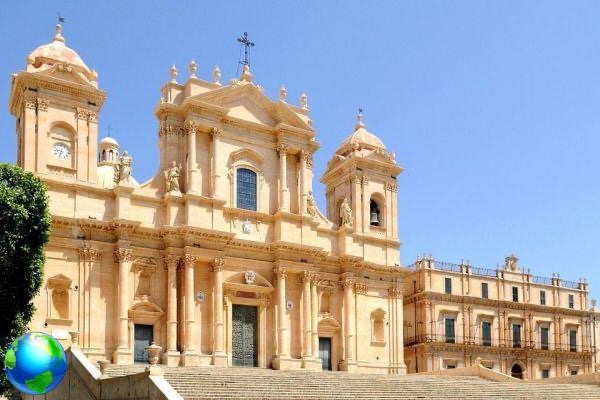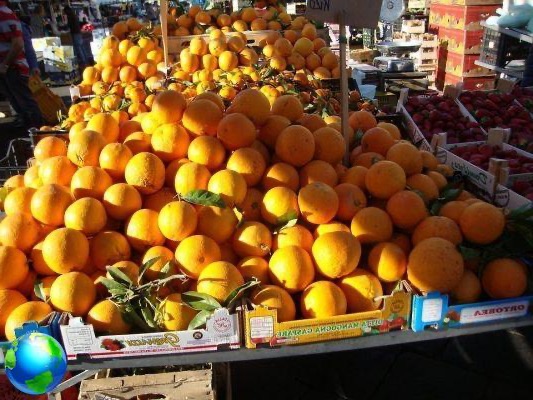Itinerary in the Val di Noto in Sicily to discover the beauties of the Sicilian land, from Catania to Ragusa, from Noto to Modica, from Scicli to Palazzolo. An itinerary full of advice and detailed with practical information on the Val di Noto.
Sicily is a land of a thousand resources. The cultural and artistic traits that characterize this fantastic region are varied: a perfect combination of the civilizations that have inhabited it throughout history. They are truly the wonders of the island, from the incredible beaches such as San Vito lo Capo to the magnificent Greek temples of Selinunte and Agrigento, passing through the wonderful expressions of Baroque art of the villages of Val di Noto. I feel particularly attached to the latter, either for the transcendental beauty of their monuments, or for the indelible memories they have left me.

The villages of the Val di Noto
Walking through the streets of the villages of the Vallo is a unique pleasure that every true travel lover should try at least once in their life; it is no coincidence that the municipalities have been included in the special list of UNESCO World Heritage sites. Caltagirone, Militello in Val di Catania, Catania, Modica, Noto, Palazzolo, Ragusa and Scicli, were literally devastated in 1693 by the "Val di Noto earthquake" and subsequently rebuilt following the style and traditional features of the Baroque era, now in its period of maximum maturity. On more than one occasion I have had the opportunity to admire the splendor of these countries which have similar characteristics, both in terms of urban organization and as regards the ornaments of the architectural structures.
1 - Caltagirone
Arranged to resemble an amphitheater, it is one of the few lucky cities that have preserved part of the ancient structures dating back to the Middle Ages. The mix of medieval features with urban planning and typically baroque features make it one of the most evocative towns of the Vallo di Noto. Very famous for its handcrafted ceramics.
2 - Militello in Val di Catania
located on the slopes of the Iblei mountains, about 35 kilometers south-west of Catania, Militello in Val di Catania is one of the symbols of the rebirth of the territory following the terrible earthquake. Unlike what happened for other villages, Militello was rebuilt on the rubble of the original village, rather than moved to other better connected areas. The symbol of the reconstruction is Palazzo Baldanza-Denaro, located in the Town Hall Square, characterized by a sumptuous facade, rich in imaginative decorations, worthy of the best Baroque island tradition. The Mother Church, in via Umberto I, is another great example of the Baroque style, as is the Sanctuary of Santa Maria della Stella.


3 - Catania
The historic center of Catania, on the other hand, is among the most beautiful ever seen in Sicily. Every time I go back to visit the city I realize how lucky the inhabitants are who can enjoy such a fantastic panorama every day. Despite being devastated several times by natural disasters, Catania seems to rise again more and more beautiful. The main facade of the Cathedral, the Badia di Sant'Agata and the church of San Giuliano, were built by the well-known architect Giovanni Battista Vaccarini. Among other things, the Catania area includes places of immeasurable beauty, steeped in history, magic and legends. This is the case of the imposing volcano Etna, as well as the Riviera dei Ciclopi, places linked to the myth of the Giants of Sicily, which according to some legends were among the first inhabitants of the island.
4 - Modica
The delightful Modica, birthplace of the poet Salvatore Quasimodo, shows more than the others the connotations of the Sicilian declination of the Baroque style, characterized by very rich decorations, intolerant of limits and above all great freedom in the invention of strange and twisted scenographic forms; the Cathedral of San Giorgio, the Church of San Pietro and the “Duomo” of the lower city are the structures that I think are most appreciable. I recommend you take advantage of the visit to the city to stock up on the delicious Modica chocolate, the best ever eaten in my life.
5 - Known
Among the Baroque cities of Sicily, Noto is probably the most beautiful. Following the earthquake, the city was rebuilt on a new site just under 20 km away. The main attractions of this pretty city, full of opulent honey-colored buildings, include the Town Hall Square, which is the main square of the town; the Duomo, which is said to have been inspired by the Roman works of Borromini; and the splendid Palazzo Villadorata, with its richly decorated balconies. Noto also has a beautiful Baroque theater, the Teatro Comunale Vittorio Emanuele, with a decorated auditorium that is open to the public.


6 - Palazzolo
Palazzolo Acreide boasts two churches listed among the UNESCO world heritage sites: the Basilica of San Paolo and the Church of San Sebastiano. But the city also boasts an ancient history. Originally built on the top of the Akrai hill in the Iblei Mountains, it was founded for military purposes by the ancient Greeks of Syracuse, who wanted to control the road to Gela. Like many other towns in the Val di Noto it was partially destroyed by the earthquake of 1693 and rebuilt in the style of Sicilian Baroque.
7 - Ragusa
The earthquake of 1693 destroyed Ragusa dividing it in two. The original part, now known as Ragusa Ibla, remained in the steep hill overlooking the valley. The remainder of the city developed further west. Fortunately, the inhabitants of the ancient part were stubborn about the reconstruction of the old city center, giving life to some of the most spectacular examples of Baroque architecture in Sicily. Ragusa Ibla has been completely renovated and today is a delightful place to explore, thanks to incredible architecture such as the Duomo and the Church of Purgatory.
8 - Scicli
A few kilometers south of Modica, the charming Scicli is less known than the other Baroque cities of Sicily, but still worth a visit for its evocative Baroque charm. Via Francesco Mormina Penna, the main street of the city, is walkable and has many nice shops, while the main monuments are the Palazzo Beneventano, with its magnificent balconies sculpted by grotesque faces, and the Church of San Bartolomeo.


Visit to Val di Noto: itinerary and useful tips
How to reach us: Val di Noto is located in Eastern Sicily. L'reference airport is that of Catania-Fontanarossa, less than 8 km from the city of Catania, about 18 minutes. Catania is the first stop on the itinerary we propose.
Getting around: your own vehicle is essential to move easily between the various stages of the itinerary. We therefore recommend hiring a car directly at the airport. For offers and rates visit the site hertz
Recommended period: the best time to visit the Val di Noto is spring, perhaps on the occasion ofInfiorata of Noto
Accomodation: The itinerary we propose is divided into 4 days and 3 nights. It is advisable to make a base for the night in the municipalities of Militello, Noto and Scicli. Noto is slightly more expensive. For offers and accommodation solutions visit the site Trovavacanzesicilia.it


























